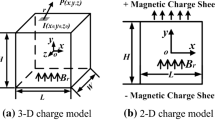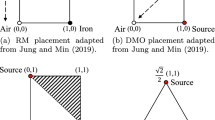Abstract
This paper proposes a topology optimization formulation for the three-dimensional (3-D) design of segmented permanent magnet (PM) arrays. Specifically, the proposed formulation aims to find an optimal 3-D structural topology of PM segments and their discrete magnetization directions. To achieve this, a design variable is defined in the vector form of a Cartesian coordinate system. The magnitude of the design variable vector determines a PM density, and the directional cosines of the vector determine PM magnetization directions. To acquire a segmented PM design with discrete magnetization directions, a PM strength penalization scheme is proposed. In this scheme, a PM strength is controlled using a minimum distance function between a magnetization direction and target discrete directions. Here, the minimum distance function is approximated using the p-norm for sensitivity calculation. To validate the effectiveness of the proposed formulation, three design examples are provided. In the first example, a two-dimensional (2-D) dipole Halbach cylinder is designed to confirm that the proposed formulation can be applied for a 2-D design problem. The second example aims to design 3-D dipole PM arrays with a cuboid cavity. In the third example, a 3-D PM arrays are designed for maximizing the magnetic force acting on a soft ferromagnetic material.



















Similar content being viewed by others
References
Albert C, Huber C, Brunckner F, Vogler C, Wautischer G, Suess D (2017) A fast finite-difference algorithm for topology optimization of permanent magnets. J Appl Phys 122:113904
Asai Y, Ota T, Yamamoto T, Hirata K (2017) Proposed of novel linear oscillating actuator’s structure using topology optimization. IEEE Trans Magn 53(6):8203204
Bendsøe MP, Kikuchi N (1988) Generating optimal topologies in structural design using a homogenization method. Comput Methods Appl Mech Eng 71:197–224
Bendsøe MP, Sigmund O (2004) Topology optimization—theory, methods and applications. Springer, Berlin
Bjørk R, Insinga AR (2018) A topology optimized switchable permanent magnet system. J Magn Magn Mater 465:106–113
Bjørk R, Bahl CRH, Insinga AR (2017) Topology optimized permanent magnet systems. J Magn Magn Mater 437:78–85
Choi JS, Yoo J (2008) Design of a Halbach magnet array based on optimization techniques. IEEE Trans Magn 44(10):2361–2366
Choi JS, Yoo J (2010) Optimal design method for magnetization directions of a permanent magnet array. J Magn Magn Mater 332(15):2145–2151
Choi JS, Yoo J, Nishiwaki S, Izui K (2010) Optimization of magnetization directions in a 3-D magnetic structure. IEEE Trans Magn 46(6):1603–1606
Choi JS, Izui K, Nishiwaki S, Kawamoto A, Nomura T (2011) Topology optimization of the stator for minimizing cogging torque of IPM motors. IEEE Trans Magn 47(10):3024–3027
Coey JMD (2002) Permanent magnet applications. J Magn Magn Mater 248(3):441–456
Dede EM, Lee J, Nomura T (2014) Multiphysics simulation: electromechanical system applications and optimization. Springer, Berlin
Halbach K (1980) Design of permanent multipole magnets with oriented rare earth cobalt material. Nucl Instrum 169(1):1–10
Huber C, Albert C, Brunckner F, Pfaff C, Kriwet J, Groenefeld M, Teliban I, Vogler C, Suess D (2017) Topology optimized and 3D printed polymer-bonded permanent magnets for a predefined external field. J Appl Phys 122:053904
Huber C, Goertler M, Abert C, Bruckner F, Groenefeld M, Teliban I, Suess D (2018) Additive manufactured and topology optimized passive shimming elements for permanent magnetic systems. Sci Rep 8:14651
Insinga AR, Smith A, Bahl CRH, Nielsen KK, Bjørk R (2019) Optimal segnetation of three-dimensional permanent-magnet assemblies. Phys Rev Appl 12:064034
Kawamoto A, Matsumori T, Yamasaki S, Nomura T, Kondoh T, Nishiwaki S (2011) Heaviside projection based topology optimization by a PDE-filtered scalar function. Struct Multidisc Optim 44:19–24
Lazarov BS, Sigmund O (2011) Filters in topology optimization as a solution to Helmholtz type differential equation. Int J Numer Meth Eng 86(6):765–781
Lee J (2010) Structural design optimization of electric motors to improve torque performance, Ph.D. dissertation, Dept. Mech. Eng. Univ. Michigan Ann Arbor
Lee J, Kikuchi N (2010) Structural topology optimization of electrical machinery to maximize stiffness with body force distribution. IEEE Trans Magn 46(10):3790–3794
Lee J, Lee J (2020) Magnetic force enhancement using air-gap magnetic field manipulation by optimized coil currents. Appl Sci 10(1):104
Lee J, Yoon SW (2015) Optimization of magnet and back-iron topologies in electromagnetic vibration energy harvesters. IEEE Trans Magn 51(6):7208807
Lee J, Seo JH, Kikuchi N (2010) Topology optimization of switched reluctance motors for the desired torque profile. Struct Multidisc Optim 42:783–796
Lee J, Dede EM, Nomura T (2011) Simultaneous design optimization of permanent magnet, coils, and ferromagnetic material in actuators. IEEE Trans Magn 47(12):4712–4716
Lee J, Dede EM, Banerjee D, Iizuka H (2012) Magnetic force enhancement in a linear actuator by air-gap magnetic field distribution optimization and design. Finite Elem Anal Des 58:44–52
Lee J, Nomura T, Dede EM (2017) Topology optimization of Halbach magnet arrays using isoparametric projection. J Magn Magn Mater 432:140–153
Lee J, Lee S-W, Kim K, Lee J (2018a) Multi-material topology optimization of magnetic actuator with segmented permanent magnets. IEEE Trans Magn 54(7):8202706
Lee J, Kim D, Nomura T, Dede EM, Yoo J (2018b) Topology optimization for continuous and discrete orientation design of functionally graded fiber-reinforced composite structures. Compos Struct 201:217–233
Lee J, Yoon M, Nomura T, Dede EM (2018c) Topology optimization for design of segmented permanent magnet arrays with ferromagnetic materials. J Magn Magn Mater 449:571–581
Lee J, Yoo J, Min S, Yoon M (2019) Topology optimization of anisotropic magnetic composites in actuators using homogenization design method. Struct Multidisc Optim 60:1423–1436
Nomura T, Dede EM, Lee J, Yamasaki S, Matsumori T, Kawamoto A, Kikuchi N (2015) General topology optimization method with continuous and discrete orientation design using isoparametric projection. Int J Numer Meth Eng 101(8):571–605
Park S, Min S, Yamasaki S, Nishiwaki S, Yoo J (2008) Magnetic actuator design using level set based topology optimization. IEEE Trans Magn 44(11):4037–4040
Petrovic M, Nomura T, Yamada T, Izui K, Nishiwaki S (2018) Orthotropic material orientation optimization method in composite laminates. Struc Multidisc Optim 57:815–828
Putek P, Pulch R, Bartel A, Maten EJW, Günther M, Gawrylczyk KM (2016) Shape and topology optimization of a permanent -magnet machine under uncertainties. J Math Ind 6:11
Sasaki H, Igarashi H (2019) Topology optimization accelerated by deep learning. IEEE Trans Magn 55(6):7401305
Svanberg K (1987) The method of moving asymptotes—a new method for structural optimization. Int J Numer Meth Eng 24(2):359–373
Svanberg K (2002) A class of globally convergent optimization methods based on conservative convex separable approximations. SIAM J Optim 12(2):555–573
Teyber R, Trevizoli PV, Christiaanse TV, Govindappa P, Niknia I, Rowe A (2017) Permanent magnet design for magnetic heat pumps using total cost minimization. J Magn Magn Mater 442: 87–96
Teyber R, Trevizoli PV, Christiaanse TV, Govindappa P, Rowe A (2018) Topology optimization of reduced rare-earth permanent magnet arrays with finite coercivity. J Appl Phys 123:193903
Wang S, Youn D, Moon H, Kang J (2005) Topology optimization of electromagnetic systems considering magnetization direction. IEEE Trans Magn 41(5):1808–1811
Wang Z, Huber C, Hu J, He J, Suess D, Wang S (2019) An electrodynamic energy harvester with a 3D printed magnet and optimized topology. Appl Phys Lett 114:013902
Yamashita Y, Okamoto Y (2020) Design optimization of synchronous reluctance motor for reducing iron loss and improving torque characteristics using topology optimization based on the level-set method. IEEE Trans Magn 56(3):7510704
Funding
This research was supported by Basic Science Research Program through the National Research Foundation of Korea (NRF) (NRF-2019R1A2C1002808), and GIST Research Institute(GRI) grant funded by the GIST in 2020.
Author information
Authors and Affiliations
Corresponding author
Ethics declarations
Conflict of interest
The authors declare that they have no conflict of interest.
Replication of results
The proposed topology optimization formulation is based on well-known three-field SIMP method with Helmholtz filtering and relaxed Heaviside function. The implementation for this known method have been provided in the relevant references cited in this paper. The extension of the three-field SIMP for the proposed design variable vector field is described in detail in Section 2.2. Additionally, the enough information to implement the proposed penalization scheme is provided in Section 2.3. Parameters required to reproduce the numerical examples are summarized in Table 1. Additional details that is necessary for the replication of the numerical examples such as initial setting of design variables are described in each subsection of Section 4.
Additional information
Responsible Editor: Somanath Nagendra
Publisher’s note
Springer Nature remains neutral with regard to jurisdictional claims in published maps and institutional affiliations.
Rights and permissions
About this article
Cite this article
Lee, J., Lee, J., Jung, T. et al. Topology optimization for three-dimensional design of segmented permanent magnet arrays. Struct Multidisc Optim 62, 3089–3104 (2020). https://doi.org/10.1007/s00158-020-02656-7
Received:
Revised:
Accepted:
Published:
Issue Date:
DOI: https://doi.org/10.1007/s00158-020-02656-7




